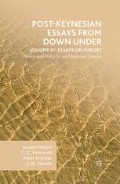Abstract
I am delighted and honoured to contribute an essay to the Special Issue of the Global and Local Economic Review in honour of Anwar Shaikh’s contributions, and especially to honour 40 years on, the publication of his wonderful HUMBUG article, “Laws of production and laws of algebra: the Humbug production function” in the February 1974 issue of The Review of Economics and Statistics.
Access this chapter
Tax calculation will be finalised at checkout
Purchases are for personal use only
Preview
Unable to display preview. Download preview PDF.
References
Bhaduri, A. (1969), “On the significance of recent controversies on capital theory: A Marxian view”, Economic Journal, 79, 532–9.
Blaug, M. (1974), The Cambridge Revolution: Success or Failure? A Critical Analysis of Cambridge Theories of Value and Distribution, London: Institute of Economic Affairs.
Brown, P. [Henry Phelps Brown] (1957), “The meaning of fitted Cobb-Douglas functions”, Quarterly Journal of Economics, 71, 546–60.
Ferguson, C.E. (1969), The Neoclassical Theory of Production and Distribution, Cambridge: Cambridge University Press.
Felipe, J. and J.S.L. McCombie (2013), “How sound are the foundations of the aggregate production function?” in Harcourt and Kriesler (eds) (2013), 202–30.
Fisher, F.M (1971), “Aggregate production functions and the explanation of wages: A simulation experiment”, Review of Economics and Statistics, 53, 305–25.
Foley, D.K. and T. Michl (1999). Growth and Distribution. Cambridge, Mass: Harvard University Press.
Harcourt, G.C. (1969), “Some Cambridge Controversies in the theory of capital”, Journal of Economic Literature, 7, 369–405.
Harcourt, G.C. (1972), Some Cambridge Controversies in the Theory of Capital, Cambridge: Cambridge University Press.
Harcourt, G.C. (1976), “The Cambridge controversies: Old ways and new horizons — or dead end?”, Oxford Economic Papers, 28, 25–65.
Harcourt, G.C. and Peter Kriesler (eds) (2013), The Oxford Handbook of Post-Keynesian Economics, Volume 2. New York: Oxford University Press.
Harris, D.J. (1975), “The theory of economic growth: A critique and reformulation”, American Economic Review. Papers and Proceedings, 65, 329–37.
Harris, D.J. (1978), Capital Accumulation and Income Distribution, Stanford: Stanford University Press.
Harrod, R.F. (1939), “An essay in dynamic theory”, Economic Journal, 49, 14–33.
Kaldor, N. (1957), “A model of economic growth”, Economic Journal, 67, 591–624.
Kalecki, M. (1936), “Pare uwag o teorii Keynesa” (“Some remarks on Keynes’ theory”), Ekonomista, 3, reprinted in C.W., vol I , 223–32.
Nell, Edward J. (ed.) (1980), Growth, Profits and Property. Essays in the Revival of Political Economy. Cambridge: Cambridge University Press.
Osiatynski, J. (ed.) (1990), Collected Works of Michał Kalecki, vol I: Capitalism, Business Cycles and Full Employment. Oxford: Clarendon Press.
Robinson, Joan (1962), Essays in the Theory of Economic Growth. London: Macmillan.
Robinson, Joan (1971), Economic Heresies: Some Old-fashioned Questions in Economic Theory. London: Macmillan.
Samuelson, Paul A. (1997), “Wherein Do the European and American Models Differ?”, Address delivered at the Bank of Italy, October 2, 1997, Number 30, mimeo.
Shaikh, Anwar (1973), “Theories of Value and Theories of Distribution”, Ph.D Dissertation, New York: Columbia University.
Shaikh, Anwar (1974), “Laws of production and laws of algebra: The Humbug production function”, Review of Economics and Statistics, 54, 115–20.
Shaikh, Anwar (1980), “Laws of production and laws of algebra: Humbug II”, in Nell (ed.) (1980), 80–95.
Shaikh, Anwar (1997), “Marx’s theory of value and the transformation problem”, in Jesse Schwartz (ed.), The Subtle Anatomy of Capitalism. Santa Monica: Goodyear Publishing Company, 106–39.
Shaikh, Anwar (1998), “The empirical strength of the labor theory of value”, in Riccardo Bellofiore (ed.), Marxian Economics: A Reapppraisal. London: Macmillan, Vol. 2, 225–51.
Shaikh, Anwar and E. Ahmet Tonak (1994), Measuring the Wealth of Nations: The Political Economy of National Accounts. Cambridge: Cambridge University Press.
Simon, H. and F. Levy (1963), “A note on the Cobb-Douglas function”, Review of Economic Studies, 30, 93–94.
Solow, R.M. (1956), “A contribution to the theory of economic growth”, Quarterly Journal of Economics, 70, 65–94.
Solow, R.M. (1957), “Technical change and the aggregate production function”, Review of Economics and Statistics, 39, 312–20.
Solow, R.M. (1974), “Laws of production and laws of algebra: A comment”, Review of Economics and Statistics, 56, 121.
Sraffa, Piero (1926), “The laws of returns under competitive conditions”, Economic Journal, 36, 535–50.
Targetti, F. and B. Kinda-Hass (1982), “Kalecki’s review of Keynes’ General Theory”, Australian Economic Papers, 21, 244–60.
Copyright information
© 2016 Joseph Halevi, G. C. Harcourt, Peter Kriesler and J. W. Nevile
About this chapter
Cite this chapter
Harcourt, G.C. (2016). The Importance of HUMBUG in The Cambridge-Cambridge Controversies in Capital Theory. In: Post-Keynesian Essays from Down Under Volume IV: Essays on Theory. Palgrave Macmillan, London. https://doi.org/10.1057/978-1-137-47529-9_26
Download citation
DOI: https://doi.org/10.1057/978-1-137-47529-9_26
Published:
Publisher Name: Palgrave Macmillan, London
Print ISBN: 978-1-137-47528-2
Online ISBN: 978-1-137-47529-9
eBook Packages: Economics and FinanceEconomics and Finance (R0)

